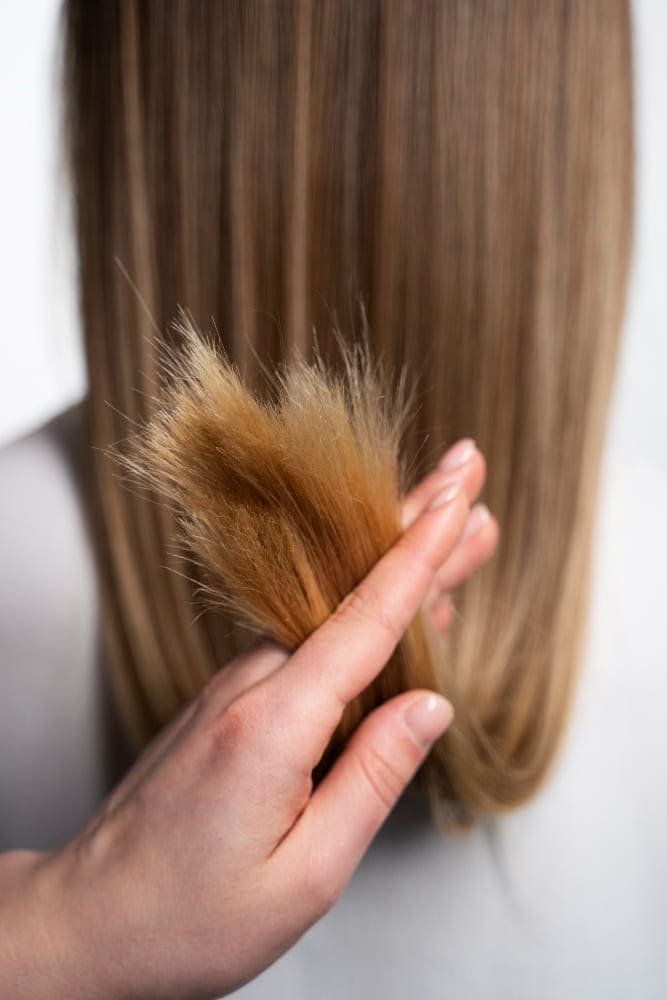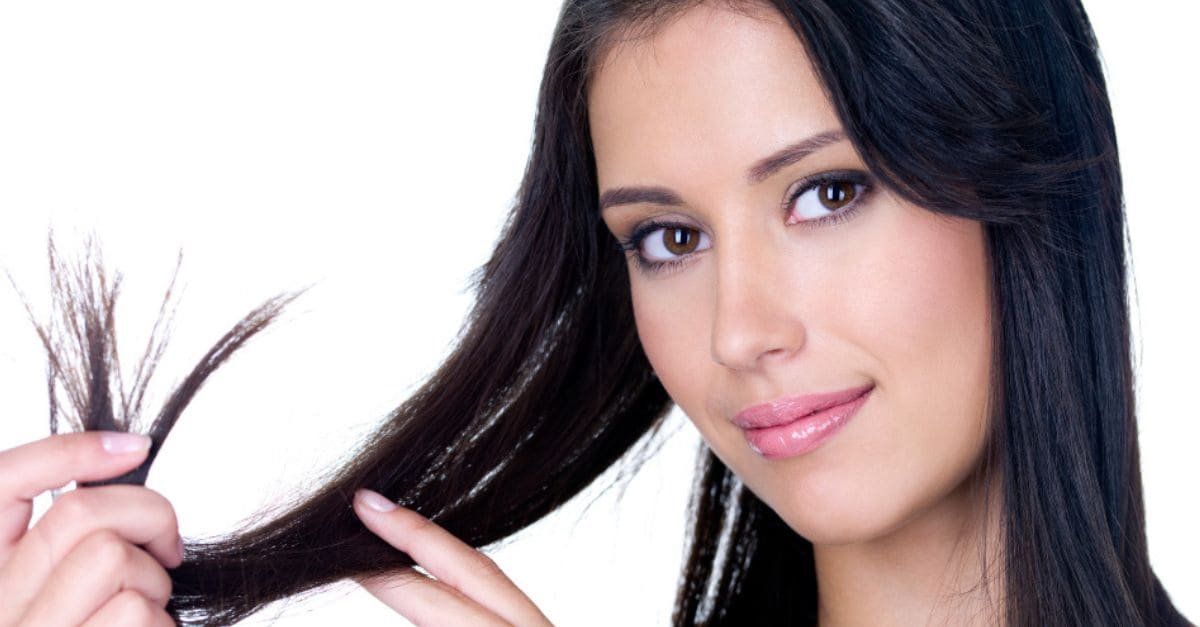Inside Article
Split Ends Stop Hair Growth
Hair — that crown of natural beauty — is often the subject of much speculation, particularly when it comes to the issue of split ends and hair growth. For the uninitiated, split ends occur when the protective outer layer of the hair cuticle wears away due to factors like heat, chemicals, and mechanical stress. While many believe that split ends represent an unshakeable obstacle to luscious, long locks, the reality is more complex. This comprehensive guide explores the interplay between split ends and hair growth, offering solutions and shedding light on the often misunderstood relationship between the two.
Understanding Split Ends: More Than a Cosmetic Concern
Before we address the impact of split ends on hair growth, it’s essential to understand the nature of this common hair woe. Split ends, scientifically known as trichoptilosis, occur when the hair shaft begins to separate into smaller strands, exposing the delicate inner cortex. This frayed, damaged condition leaves hair looking unkempt and dull and can impact the hair’s overall health.
Causes of Split Ends
Several factors contribute to the formation of split ends. The most common culprits include:
- Heat styling: Excessive use of blow dryers, curling irons, or straighteners can damage hair.
- Chemical treatments: Dyeing, bleaching, and perming procedures can weaken the hair structure.
- Mechanical stress: Vigorous brushing, combing, and the use of rough hair accessories can cause breakage.
- Environmental elements: Exposure to sun, wind, and cold can strip moisture from the hair.
Prevention Strategies for Split Ends

- Regular trims to remove existing splits and prevent them from traveling up the hair shaft.
- Use gentle hair care products and limit the use of chemicals.
- Protective styling to minimize exposure to physical and environmental stressors.
- Deep conditioning treatments to maintain moisture and elasticity in the hair.
- Adjusting hair routines, such as washing less frequently or with cooler water.
Split Ends vs. Hair Growth: A Common Misconception
The prevailing wisdom is that the presence of split hairs directly inhibits the growth of hair, but this is not entirely accurate. While it’s true that split ends can lead to breakage and stunted length retention, they do not stop hair from growing at the root level.
The Truth About Length and Health
Hair that is suffering from significant split ends is weaker and more prone to breakage. When the hair shaft breaks, it does not grow back from the same point, but the portion of the hair that remains attached to the scalp will continue to grow. This means that while splits may not stop hair from growing, they can certainly impede the ability of hair to reach its full-length potential.
Cutting vs. Treating Split Ends
When it comes to split hairs, the forerunner in the debate is whether to cut or to treat. This decision often boils down to the severity of the damage:
- For minor damage, treatment options such as deep conditioning and protective hairstyles may be effective.
- Severe split hairs require a trim to prevent further damage and promote the appearance of healthy hair.
Protecting and Healing Your Hair
Don’t fret if you’re dealing with split hairs; there are numerous ways to protect and heal your tresses:
- Be mindful of the tools and techniques used for styling.
- Implement a regular trimming schedule.
- Adopt a healthy diet rich in hair-nourishing nutrients.
Nourishing from Within: Nutritional Essentials for Hair Growth
A nutritious diet is as crucial to hair health as it is to overall well-being. Vitamins, minerals, and essential fatty acids play a significant role in promoting hair growth and preventing split hairs.
Key Nutrients for Healthy Hair
- Proteins: Hair is primarily composed of protein. Consuming an adequate amount of protein is essential for strong, healthy hair.
- Omega-3 Fatty Acids: These healthy fats are vital for hair growth and a healthy scalp.
- Zinc and Iron: Deficiencies in these minerals are linked to hair loss and stunted growth.
- Vitamin E: An antioxidant that can help prevent oxidative stress, which can contribute to split ends.
The Power of a Balanced Diet
Incorporate a variety of foods that promote healthy hair, including salmon, avocados, nuts, and leafy greens. Consider supplements if your diet lacks these key nutrients.
Treating Split Ends: From Breakage to Brilliance

Concealing Split Ends
Moisturizing hair creams and serums can temporarily seal the cuticle, concealing split ends and making hair look healthier. Additionally, certain hairstyles can mask the appearance of splits, such as updos or those that curl the ends.
Treatment and Prevention Recipes
DIY treatments and masks made from natural ingredients can provide intense nourishment to the hair. For example, coconut oil is a popular choice for its ability to penetrate the hair shaft and moisturize from within.
The Right Haircare Routine: A Lifeline for Long, Lush Hair
Establishing a hair care routine tailored to your hair’s unique needs is an essential step in preventing split ends and promoting growth.
Essential Routine Components
- Shampoo and Conditioner: Choose products formulated for your hair type and concerns. Look for conditioners with ingredients like keratin or argan oil, which can help repair and protect against future damage.
- Styling Products: Use lightweight, nourishing products that won’t weigh hair down or cause buildup.
- Regular Trims: Schedule trims every 6-8 weeks, or as recommended by your hairstylist, to prevent split ends from worsening.
Styling with Care
- Use heat protection sprays before styling with hot tools.
- Opt for hairstyle variations to reduce stress on the same parts of your hair over time.
- Be gentle with wet hair, as it is more susceptible to damage.
Lifestyle and Behavioral Adjustments for Healthier Hair
Beyond products and treatments, your lifestyle choices can significantly impact the health and growth of your hair.
Hydration and Hair Health
- Drink plenty of water to keep your hair, as well as your skin and nails, hydrated.
- Use a humidifier in dry environments to maintain moisture levels in your hair.
Stress and Its Effects on Hair
- Manage stress through practices like meditation or exercise to prevent its negative impact on hair.
- Get enough sleep to allow your body to repair and rejuvenate, which includes your hair.
Final Thoughts
The relationship between split ends and hair growth is one of symbiosis — each aspect influences the other. While split ends do not literally stop hair growth, the breakage they cause can inhibit the visual growth and overall health of your hair. By understanding the root causes of split hairs, adopting preventive measures, and enhancing your hair care regimen with nourishing practices, you can maintain a stunning, healthy mane that has the best possible chance to fulfill its growth potential. Hair growth is a complex interaction of genetics, health, and care. Split hairs are not a direct cause of inhibited growth, they do represent weakened hair that is less likely to reach its full potential. To protect your split ends,hair growth products that stop hair breakage are the right fit for you.
Do split ends cause hair thinning?
Yes, split ends can contribute to hair thinning as they make the entire length of your hair weaker and prone to breakage. If not treated, this can lead to a noticeable decrease in hair volume over time.
Can your hair still grow if you have split ends?
Yes, your hair can still grow with split ends but the growth may not be as noticeable due to the continuous damage and breakage. Trimming split ends regularly is important for maintaining healthy and long hair.
How do you get rid of split ends without cutting?
There are a few ways to help reduce the appearance of split ends without cutting them off completely. Regular deep conditioning treatments, using a wide-tooth comb to detangle hair gently, and reducing the use of heat styling tools can all help prevent further damage and reduce the appearance of split ends. However, it’s important to note that these methods will not get rid of split ends entirely and regular trims are still recommended for maintaining healthy hair. So, it’s best to get a trim every 6-8 weeks to keep your hair looking and feeling its best.

